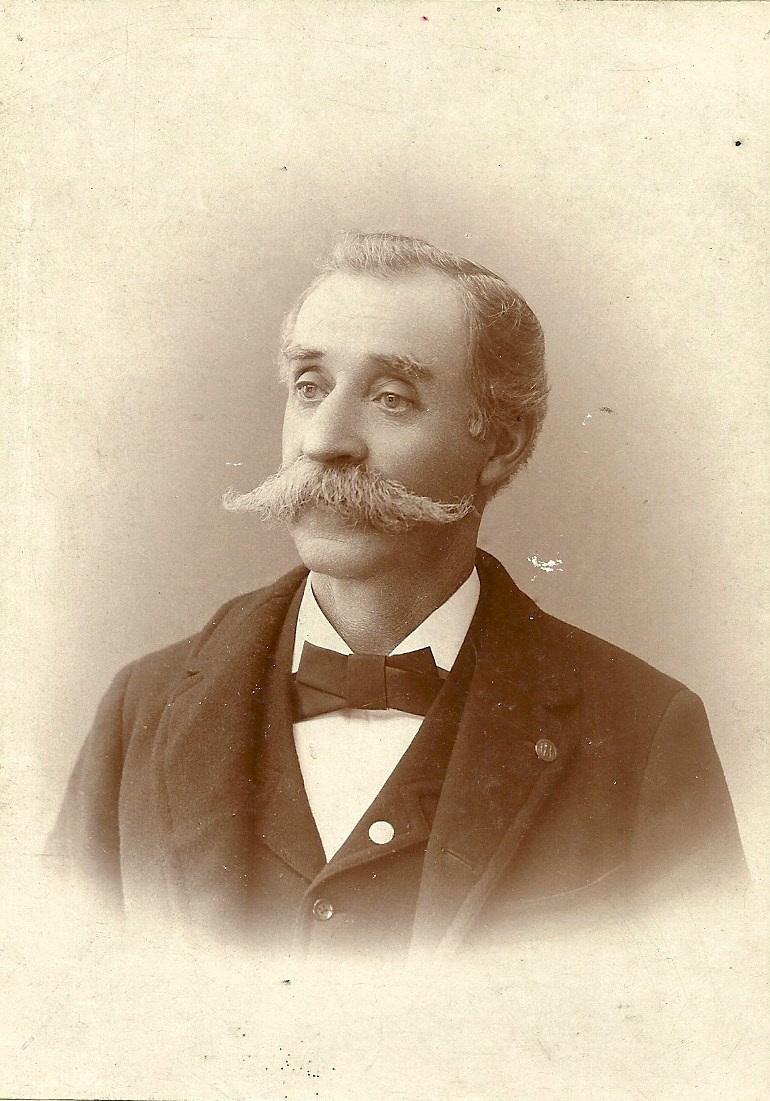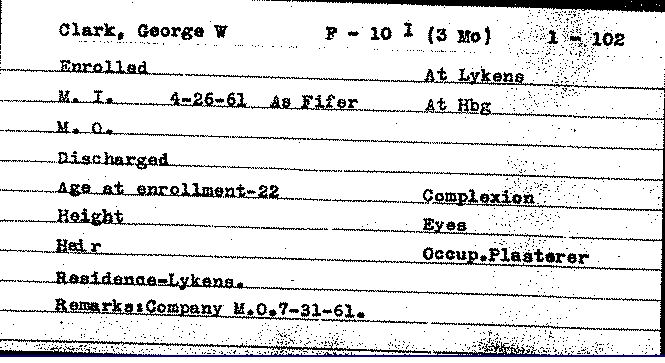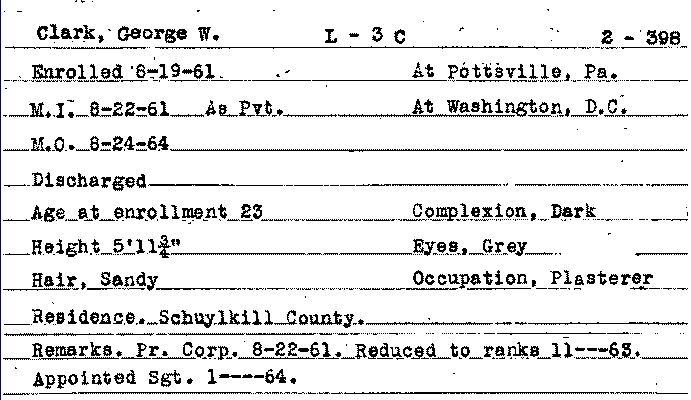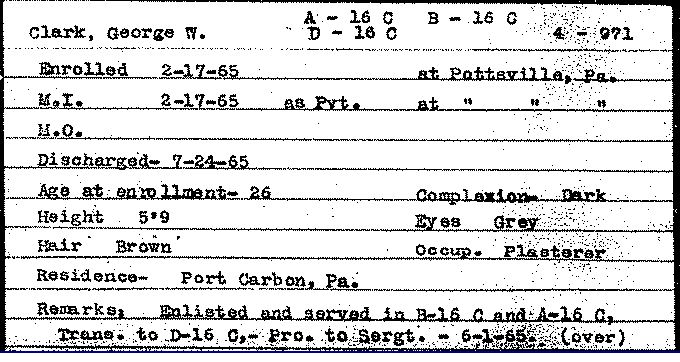Who Was George W. Clark, Musician?
Posted By Norman Gasbarro on September 9, 2015
One of several names on the Lykens G.A.R. Monument that was not previously identified as to a specific Civil War regiment and company is George W. Clark. The monument tablet only notes that he was a musician and that he was not a member of the Heilner G.A.R. Post.
In searching for him in the Pennsylvania Veterans’ Card File (Pennsylvania Archives), the above card was located. The following information can therefore be added: George W. Clark enrolled in the 10th Pennsylvania Infantry at Lykens, on or prior to his ‘muster in” on 26 April 1861 as a Fifer in Company F of that regiment. At the time he declared himself to be 22 years old, a plasterer by trade, and a resident of Lykens.
Using the information that his occupation was “plasterer,” a census search was done through Ancestry.com.
In 1870, George W. Clark is found working as a plasterer in the Williams Valley, Schuylkill County, Pennsylvania. In the household, there are 3 children and a wife, Emma J. Clark.
In 1880, George W. Clark is found working as a plasterer in Winfield, Cowley County, Kansas. The wife, Emma J. Clark, is in the household as are two of the three children named in the 1870 Census. There are also two additional children in the household, the youngest of which was born about 1875 in Pennsylvania. From this information, it can most likely be assumed that the family did not move to Kansas until sometime between 1875 and the taking of the 1880 Census.
In 1889, George W. Clark, born about 1839, and married, is found working as a plasterer in Pierce County, Washington. There are no other useful details in this state census.
In the 1890 Veterans’ Census of Tacoma, Washington, George W. Clark indicated that in addition to his service in the 10th Pennsylvania Infantry, he also served as a Sergeant in the 16th Pennsylvania Cavalry and as a Sergeant in the 3rd Pennsylvania Cavalry. That information is shown below (click on document to enlarge). George also indicated that he had “deafness” as a result of his military service.
 In 1900, George W. Clark was working as a plasterer in Tacoma, Pierce County, Washington State. In addition to his wife Emma, his household consisted of his son Allen Clark, then a widower, a youngest daughter Sadie, age 8, who was born in Kansas, and a granddaughter, possibly the daughter of Allen. Allen was working as a fireman for the city of Tacoma.
In 1900, George W. Clark was working as a plasterer in Tacoma, Pierce County, Washington State. In addition to his wife Emma, his household consisted of his son Allen Clark, then a widower, a youngest daughter Sadie, age 8, who was born in Kansas, and a granddaughter, possibly the daughter of Allen. Allen was working as a fireman for the city of Tacoma.
In 1910, George W. Clark, living in Tacoma, Washington, gave his occupation as “none.” At that time he was a widower and living in the household of his son-in-law, the husband of his daughter Hattie.
Washington State death records note that George W. Clark died on 20 Aug 1912 at Tacoma. His parent’s names as reported were William E. Clark and Hannah Cassel.
According to his Findagrave Memorial, he is buried at Tacoma Cemetery.

The grave marker (shown above) notes that George W. Clark served in the 3rd Pennsylvania Cavalry, Company L, as a Sergeant.
Returning to the records at the Pennsylvania Archives, the following Veterans’ Cards were located:
Following his service in the 10th Pennsylvania Infantry, George W. Clark enrolled in the 3rd Pennsylvania Cavalry at Pottsville and was mustered into service at Washington, D.C., on 22 August 1861 as a Private. On the same day, he was promoted to Corporal, but in November 1863, he was reduced in ranks. Later, in January 1864, he was appointed Sergeant, the rank at which he was mustered out on 24 August 1864. At the time of his enrollment, he was about 23 years old, was working as a plasterer, and was living in Schuylkill County.
George’s final enlistment occurred at Pottsville on 17 February 1865, where he was mustered into service at the same day and place in the 16th Pennsylvania Cavalry. His initial rank was Private, but the record shows he received a promotion to Sergeant on 1 June 1865. He served in Companies A, B, and D of this regiment. At the time of his enrollment, he was about 26 years old, still working as a plasterer, and residing in Port Carbon, Pennsylvania.
An additional document available on-line through Fold3, is George’s Pension Index Card (shown below).
The Pension Index Card confirms the three regiments in which George W. Clark served as well as his death year of 1912. His initial pension application was made on 24 Feb 1887.
What is interesting about these discoveries is that the Lykens G.A.R. Monument does not list George’s highest military rank – which was Sergeant. The grave marker at Tacoma Cemetery does give the rank of Sergeant – but only notes one regiment of service, albeit the one in which George served the longest. It is not known whether George lost all contact with Lykens after he moved west. The names on the Lykens G.A.R. Monument were compiled by Henry Keiser, who himself had served in the 10th Pennsylvania Infantry with George W. Clark, so Keiser may have not known that George had served as a Sergeant in a different regiment – nor did anyone else who read the published list of names that were to be included on the monument prior to its erection.
One additional fact need to be explored. The maiden name of George’s wife was Emma Jane Snyder – a surname found very frequently in the Lykens area. Her death record gives her father’s name as Josiah Snyder and her mother’s name as Sarah Messner. Perhaps a reader of this blog post can identify this couple and indicate whether they or any of their children had a continuing presence in the Lykens Valley area in the post-Civil War period – particularly into the early 20th century when the Lykens G.A.R. Monument was erected.
Additional information can be added in the comments section of this post or sent by e-mail.
—————————–
The portrait of George W. Clark was found in several public-posted Ancestry.com family trees.
 ;
;








Comments